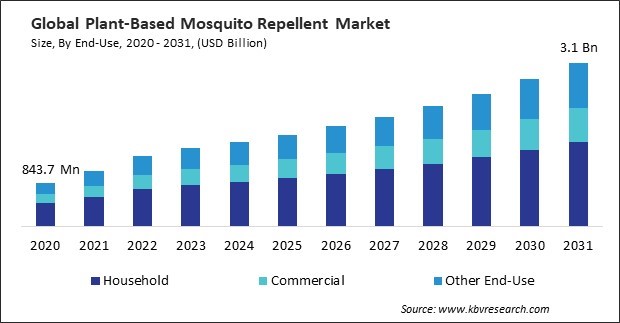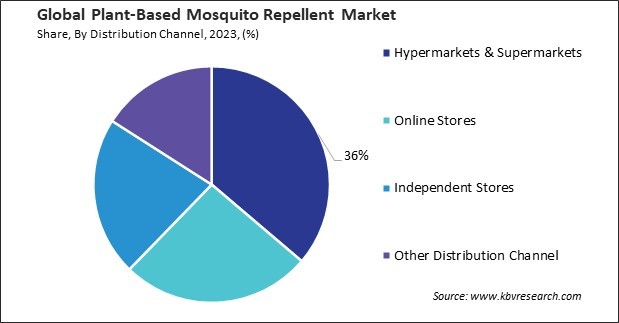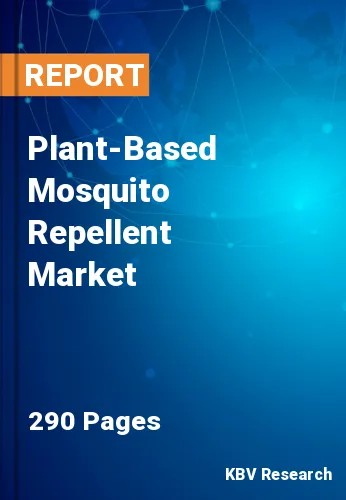“Global Plant-Based Mosquito Repellent Market to reach a market value of 3.1 Billion by 2031 growing at a CAGR of 9.8%”
The Global Plant-based Mosquito Repellent Market size is expected to reach $3.1 billion by 2031, rising at a market growth of 9.8% CAGR during the forecast period.
The preference for natural alternatives over chemical repellents is increasing as consumers become more health conscious. The market growth in the Asia Pacific region has been further bolstered by urbanization, an increase in disposable income, and heightened awareness of the health benefits of plant-based products. Thus, the Asia Pacific segment recorded 38% revenue share in the plant-based mosquito repellent market in 2023.

In general, these essential oils are non-toxic and can be used in the presence of children and pets without the dangers associated with chemical-based products, making them a superior choice for families. Hence, the rising awareness of health and environmental concerns is thus a powerful driver behind the growth of the plant-based mosquito repellent market. Additionally, Plant-based mosquito repellents, with their clear and easy-to-understand ingredient lists—often featuring essential oils like citronella, lavender, and eucalyptus—cater to this need for transparency. Unlike products with long, complex ingredient lists filled with chemicals, natural repellents offer consumers peace of mind, knowing they make a healthier choice for themselves and their families. Thus, such factors propel the growth of the market.
However, Consumers are inclined to favor the most reliable and effective alternatives in regions where mosquito-borne diseases such as dengue, malaria, and Zika are prevalent. The shorter protection time of plant-based repellents necessitates frequent reapplication, which can be seen as inconvenient or impractical, especially in high-risk areas where continuous protection is essential. People in these regions often prefer chemical repellents for their sustained action, which reduces the risk of gaps in coverage that could lead to mosquito bites and potential infections. Hence, consumers who have experienced inconsistent results with natural repellents are more likely to switch to chemical options, creating a significant barrier to plant-based mosquito repellent market growth.
On the basis of product type, the market is divided into sprays & aerosols, lotions & creams, candles & coils, and others. The sprays & aerosols segment acquired 33% revenue share in the market in 2023. Sprays and aerosols are a popular choice among consumers who are seeking a quick and effective mosquito protection solution, primarily due to the convenience and simplicity of the application they offer.
Based on distribution channel, the market is classified into hypermarkets & supermarkets, online stores, independent stores, and others. The hypermarkets & supermarkets segment garnered 36% revenue share in the market in 2023. This is largely attributed to the accessibility and convenience offered by these retail formats. Consumers are facilitated in their search for plant-based mosquito repellents, as well as other domestic and personal care items, by the extensive selection of products available at supermarkets and hypermarkets.

By end-use, the market is segmented into household, commercial, and others. The commercial segment garnered 20% revenue share in the market in 2023. This growth can be attributed to the rising use of natural mosquito repellents in public and commercial spaces such as hotels, resorts, outdoor restaurants, and wellness centers.
Based on age group, the market is fragmented into adults, children, and others. The children segment acquired 27% revenue share in the market in 2023. Parents increasingly opt for plant-based repellents for their children due to concerns over the potential side effects of synthetic chemicals in conventional repellents.
Free Valuable Insights: Global Plant-Based Mosquito Repellent Market size to reach USD 3.1 Billion by 2031
Region-wise, the market is analyzed across North America, Europe, Asia Pacific, and LAMEA. The North America segment witnessed 29% revenue share in the market in 2023. The North American market's expansion is primarily fueled by a growing consciousness of the potential health hazards associated with synthetic repellents, which has resulted in a shift in consumer preferences toward natural products.
| Report Attribute | Details |
|---|---|
| Market size value in 2023 | USD 1.5 Billion |
| Market size forecast in 2031 | USD 3.1 Billion |
| Base Year | 2023 |
| Historical Period | 2020 to 2022 |
| Forecast Period | 2024 to 2031 |
| Revenue Growth Rate | CAGR of 9.8% from 2024 to 2031 |
| Number of Pages | 290 |
| Tables | 460 |
| Report coverage | Market Trends, Revenue Estimation and Forecast, Segmentation Analysis, Regional and Country Breakdown, Porter’s 5 Forces Analysis, Company Profiling, Companies Strategic Developments, SWOT Analysis, Winning Imperatives |
| Segments covered | End-Use, Age Group, Product Type, Distribution Channel, Region |
| Country scope |
|
| Companies Included | S. C. Johnson & Son, Inc., Reckitt Benckiser Group PLC, Henkel AG & Company, KGaA, Spectrum Brands Holdings, Inc., Johnson & Johnson Services, Inc. (Johnson & Johnson), Dabur India Ltd., Natura & Co Holding SA, 3M Company, Godrej Consumer Products Ltd. (Godrej Group) and Himalaya Wellness Company (Himalaya Global Holdings Ltd.) |
By End-Use
By Age Group
By Product Type
By Distribution Channel
By Geography
This Market size is expected to reach $3.1 billion by 2031.
Rising awareness of health and environmental concerns are driving the Market in coming years, however, Limited efficacy compared to chemical repellents restraints the growth of the Market.
S. C. Johnson & Son, Inc., Reckitt Benckiser Group PLC, Henkel AG & Company, KGaA, Spectrum Brands Holdings, Inc., Johnson & Johnson Services, Inc. (Johnson & Johnson), Dabur India Ltd., Natura & Co Holding SA, 3M Company, Godrej Consumer Products Ltd. (Godrej Group) and Himalaya Wellness Company (Himalaya Global Holdings Ltd.)
The expected CAGR of this Market is 9.8% from 2024 to 2031.
The Household segment is leading the Market by End-Use in 2023; thereby, achieving a market value of $1.6 billion by 2031.
The Asia Pacific region dominated the Market by Region in 2023, and would continue to be a dominant market till 2031; thereby, achieving a market value of $195.8 million by 2031.
Our team of dedicated experts can provide you with attractive expansion opportunities for your business.

 Drivers
Drivers
 Restraints
Restraints
 Opportunities
Opportunities
 Challenges
Challenges
